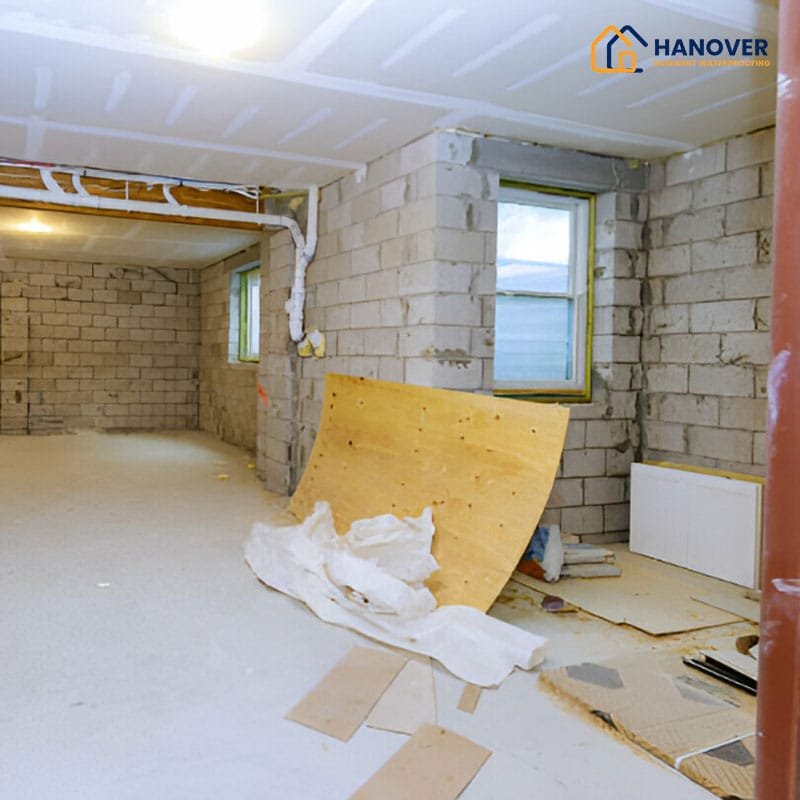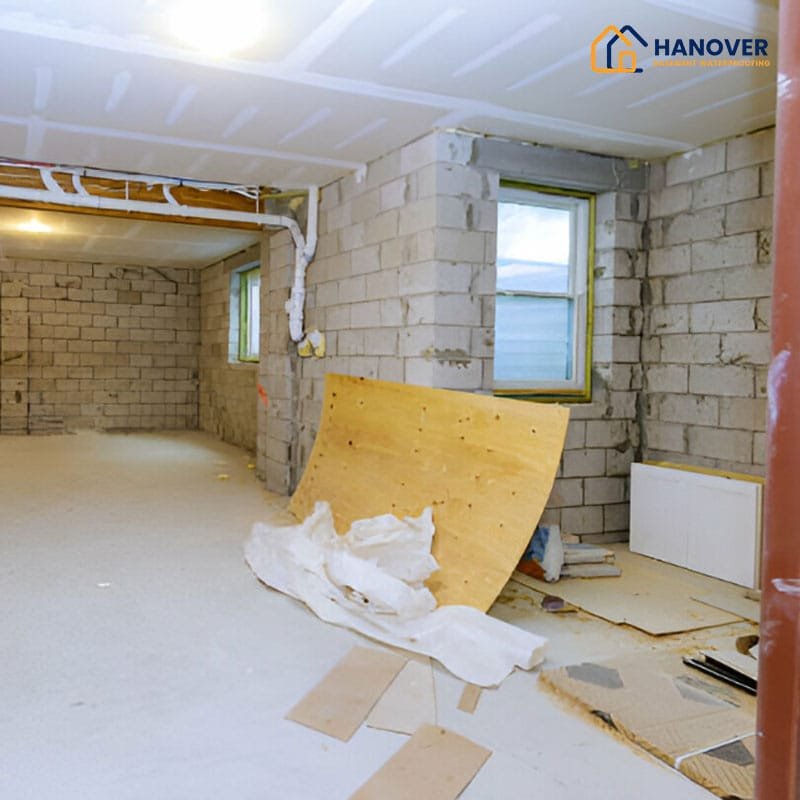Basement Repair Risks
When it comes to basement repair decisions, many homeowners face a tempting trade-off: tackle the issue themselves or hire a licensed professional. What often seems like a way to save money can quickly evolve into a series of costly structural setbacks. The difference between a successful fix and a flooded disaster often depends on how well you understand the underlying causes of damage and the limits of personal skill.
Basement structural problems are rarely cosmetic. Whether you’re dealing with foundation cracks, hydrostatic pressure buildup, or interior mold infestation, your repair method must match the problem’s severity. DIY solutions might hold for a season, but long-term effectiveness requires precise diagnostics, correct material use, and reliable labor—skills that professionals bring with experience.
If you’re seeing stair-step cracks, consider scheduling foundation repair services to prevent worsening structural shifts.
Common DIY Mistakes That Lead to Greater Damage
Incorrect Crack Repair Techniques
One of the most frequent errors in basement repairs is applying surface-level patching materials to visible wall cracks. Homeowners often use over-the-counter hydraulic cement or flexible epoxy tubes without understanding if the crack is due to settlement, lateral soil pressure, or water infiltration. Applying the wrong product traps moisture, leading to internal concrete spalling or foundation movement that continues unchecked.
Improper Waterproofing Practices
Another major DIY mistake is applying waterproofing paints like DRYLOK to interior basement walls while ignoring exterior drainage. These materials may block surface moisture, but they fail against groundwater intrusion that presses against your foundation wall. Without exterior trenching, french drain installation, or proper downspout extensions, the underlying water pressure builds until walls bow or crack.
Failure to Diagnose Source of Moisture
Homeowners often attempt to dry out a musty basement using dehumidifiers or ventilation fans alone. While these tools reduce humidity temporarily, they do not solve the cause—such as clogged weeping tiles, poor exterior grading, or gutter runoff pooling at the foundation. This can lead to unchecked black mold formation, which is costly to remediate and dangerous to health.
Use of Inappropriate Tools and Materials
Most DIY kits come with generic fillers, sealants, and patching tools that are not suited for load-bearing wall cracks or recurring moisture exposure. For instance, using latex caulk on structural gaps allows seasonal expansion to reopen them, defeating the repair’s intent. Professional repairs include reinforcement bars, high-pressure injection systems, and non-shrink grout mixes which DIY methods cannot replicate.
Financial Implications of Poor DIY Repair
Repairing the Same Issue Multiple Times
When DIY solutions fail, homeowners often reattempt the fix—applying new patches, adding more fans, or experimenting with different sealants. This leads to repetitive material costs, higher electric bills, and significant time loss. Worse, many homeowners eventually hire a contractor anyway, who must remove the DIY patchwork before applying a proper solution, increasing labor time and total cost.
Long-Term Structural Damage
Unresolved water infiltration and structural cracks grow worse over time. A small horizontal crack may signal lateral foundation pressure, which if left untreated, leads to wall buckling or collapse. At this point, foundation underpinning, steel I-beam installation, or wall rebuilding may be necessary—costing tens of thousands of dollars. Professional early intervention could have prevented this escalation.
Insurance and Property Value Risks
DIY repairs that are undocumented or poorly executed can void home insurance claims for water or structural damage. If a future claim arises and it’s proven the homeowner bypassed required permits or inspections, the insurer may deny coverage. Additionally, home resale value can suffer if visible cracks, dampness, or odor linger in the basement. Professional repairs usually come with transferable warranties—a major plus during home appraisals.

Cost Comparison: DIY vs. Professional Repairs
Initial Cost Savings of DIY
The appeal of DIY basement repair is usually tied to the lower upfront cost. Most basic materials—such as patch kits, sealants, and mold-resistant paints—are accessible for under $100. Homeowners often believe they can complete the work over a weekend, minimizing labor expenses. However, this perception rarely accounts for the hidden costs of repeated failure, tool rentals, or missed root causes.
For example, a DIY hydraulic cement application kit for crack sealing might cost $75–$100. Add another $50–$100 for waterproofing paint and accessories, and the total seems manageable. But if the underlying issue is lateral pressure or poor drainage, these materials will fail, leading to a required professional fix—this time with added demolition of DIY layers.
A professionally installed sump pump system can prevent hydrostatic pressure buildup and recurring basement leaks.
Professional Service Pricing Breakdown
Professional basement repair services vary in cost based on scope, materials, and location. In Hanover, PA, typical rates fall within these national ranges:
- Crack injection and sealing: $500–$1,500 per crack
- Interior drain tile system: $3,000–$7,000 for full basement perimeter
- Exterior excavation and waterproofing: $8,000–$15,000 depending on accessibility
- Mold remediation: $1,000–$3,500 depending on square footage
- Structural reinforcement with carbon fiber or steel I-beams: $1,500–$4,000 per wall
Although higher upfront, these services usually include material warranties, certified inspections, and engineering reports, which add long-term value and minimize future repair costs.
Soil and Climate Factors in Hanover, PA
Regional Soil Composition and Its Effects
Hanover’s soil includes a mix of clay and loam, which are highly expansive. These soils swell when saturated and shrink in dry conditions, creating intense pressure against basement walls. DIY approaches—especially those that focus on internal fixes alone—do not address this soil-structure interaction. Professionals mitigate these risks through exterior pressure relief systems and deep drainage design.
Seasonal Water Infiltration Patterns
In Pennsylvania’s climate, freeze-thaw cycles and heavy spring rainfall can cause rapid water table shifts. These shifts lead to crack propagation, concrete degradation, and subsurface saturation. DIY measures rarely account for these patterns, resulting in recurring water intrusions that become more severe over time.
Professional contractors in Hanover often integrate sump pump systems, battery backups, and gravity drains, designed with regional hydrology in mind.
Material Quality: DIY Kits vs. Contractor-Grade Supplies
Consumer-Grade Material Limitations
Most DIY kits available at hardware stores include low-pressure epoxies, paint-on waterproofing membranes, or flexible caulking compounds. These materials work for superficial or cosmetic fixes, but they do not bond with wet concrete, lack expansion flexibility, and cannot resist hydrostatic pressure.
Contractor-Grade Solutions and Tools
Professional crews use high-pressure polyurethane injection systems, carbon fiber reinforcement strips, and engineered drainage mats. These materials are:
- Rated for moisture resistance
- Compatible with load-bearing walls
- Compliant with building codes
They are also often tested for freeze-thaw durability—a necessity in regions like Hanover. Unlike DIY products, these materials offer long-term protection against water ingress, mold formation, and structural failure.
When Should You DIY and When Should You Hire a Professional?
Appropriate Scenarios for DIY Repairs
Some minor issues in basement maintenance can be addressed by homeowners with basic skills and precautions. These include:
- Surface mold cleaning using safe biocides on non-porous surfaces
- Applying dehumidifiers to manage mild humidity levels
- Recaulking windows or replacing minor weather stripping
- Simple cosmetic crack sealing that is hairline and not leaking
These projects require limited risk, minimal tools, and can be resolved with clear visibility into the problem. However, it is critical that these fixes are not masking deeper issues like foundation movement or water ingress under pressure.
Signs You Need Professional Help Immediately
If your basement displays any of the following, you should consult a licensed contractor:
- Horizontal or stair-step foundation cracks
- Persistent standing water
- Mold or mildew smell returning after cleaning
- Efflorescence or visible salt deposits on walls
- Floor slab heaving or soft spots
- Leaks around utility penetrations
These conditions suggest systemic problems with the foundation integrity, moisture barrier, or subsurface drainage, which cannot be safely or effectively corrected through DIY methods.
Warranties, Inspections, and Permits: DIY vs. Pro Comparison
Warranty and Coverage Differences
DIY repairs do not carry warranties. If the solution fails, the cost of material, time, and further damage is borne entirely by the homeowner. In contrast, most professional basement repair companies offer:
- Written warranties ranging from 5 years to lifetime coverage
- Transferable agreements if the home is sold
- Backed inspections to validate the quality of work
These safeguards protect your investment and can improve your position during home resale or mortgage refinancing.
Inspection and Permit Requirements
In municipalities like Hanover, PA, certain basement repairs—especially structural modifications, sump installations, or exterior drainage—require permits. A professional contractor manages:
- Permit applications
- Engineering review (if needed)
- Compliance with local building codes
DIY efforts that skip these steps can lead to code violations, fines, or insurance voiding in case of a claim. Always consult your township’s code office before initiating a major repair project on your own.
Final Checklist for Hanover Homeowners
Before beginning any basement repair—DIY or professional—use this checklist to ensure informed decision-making:
- Assess moisture level: Is it persistent or seasonal?
- Examine cracks: Are they surface-level or structural?
- Identify source: Is the issue caused by rainwater, plumbing, or soil pressure?
- Measure skill requirement: Do you have the tools, safety knowledge, and time?
- Check for mold: Has it penetrated porous materials like drywall or wood framing?
- Review code requirements: Are permits or inspections required?
- Get professional opinion: Even one consultation can help define scope and cost.
Conclusion: Invest Early, Save Long-Term
The temptation to manage basement repairs independently is understandable. Yet the risks associated with missed diagnoses, inadequate materials, and improper execution often outweigh short-term savings. Professional repair services offer not just deeper expertise but peace of mind, safety compliance, and financial protection.
In high-risk zones like Hanover, PA, where soil, moisture, and climate variability challenge even experienced builders, professional help ensures your foundation—and your home’s value—remain secure.
FAQs
What Are the Risks of DIY Basement Repairs?
DIY repairs can mask deeper problems instead of fixing them. Using the wrong materials or techniques can worsen cracks, water damage, and foundation instability. If a repair fails, it often costs more to fix than calling a professional in the first place.
How Much Can I Save by Doing Basement Repairs Myself?
For minor issues, DIY repairs can save a few hundred dollars. However, if a DIY fix fails or worsens the problem, you could spend thousands on professional repairs later. Experts best handle structural issues and waterproofing problems to avoid costly mistakes.
When Should I Call a Professional for Basement Repairs?
Call a professional if you notice:
- Large or widening cracks in basement walls or floors.
- Water leaks or persistent dampness, even after DIY fixes.
- Bowing or shifting walls indicate foundation movement.
- Mold growth, which signals ongoing moisture problems.
- Uneven floors or sinking foundation sections.
How Long Do Professional Basement Repairs Last?
Professional basement repairs typically last decades; many come with 10 years to a lifetime warranty. Unlike DIY fixes, which may need constant reapplication, expert repairs address the root cause of the problem, ensuring long-term protection.
Does Home Insurance Cover Basement Repair Costs?
Most home insurance does not cover basement repairs caused by normal wear, poor maintenance, or foundation settling. However, some costs may be covered if the damage is due to a covered event (like a burst pipe or flood, depending on your policy). Always check your policy details or contact your provider for confirmation.

